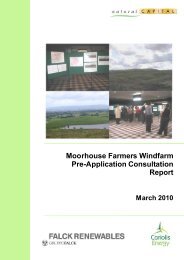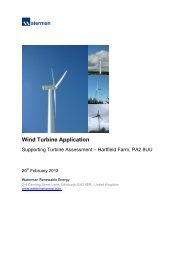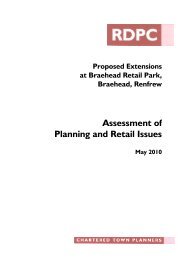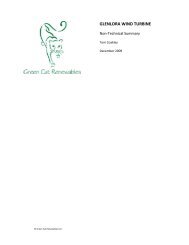Supporting documents - Renfrewshire Council
Supporting documents - Renfrewshire Council
Supporting documents - Renfrewshire Council
Create successful ePaper yourself
Turn your PDF publications into a flip-book with our unique Google optimized e-Paper software.
© Green Cat Renewables Ltd<br />
GLENLORA WIND TURBINE<br />
In the Climate Change Programme, the Scottish Government outlines its vision for<br />
Scotland: ‘We want Scotland to become recognised as the best small country in the<br />
world and one of the ways we can do that is through our actions to tackle climate<br />
change. The Scottish Executive is committed to playing its part in full, encouraging<br />
others to do likewise … we have a moral responsibility to reduce our carbon footprint<br />
....”<br />
3.1.3 Baseline Data<br />
The SNH Technical Guidance Review suggests that carbon dioxide savings associated<br />
with any wind project development in the UK should be calculated assuming that wind<br />
energy displaces carbon emissions produced per unit of electricity generated from<br />
fossil fuel sourced grid mix. The new guideline explains that wind power does not<br />
displace renewable and nuclear generation and therefore that the counterfactual<br />
factors to use should be the fossil fuel mix factor rather than the grid mix.<br />
The annual carbon dioxide emissions saving of a wind turbine are estimated as:<br />
CO2 emissions saving = total electricity generation expected [MWh] x Emission<br />
Factor of Displaced Generation [tCO2/MWh]<br />
Capacity Factor<br />
In calculating the total electricity generation expected, a wind project capacity factor<br />
has to be determined. This is the ratio of the actual energy generated to the<br />
theoretical amount that the machine would generate if running at full rated power<br />
during a given period of time. The average capacity factor observed for the onshore<br />
windfarms in the UK between 2003 and 2007 is 27.3% 3 . The Scottish average is<br />
believed to be better thanks to higher wind speeds blowing more frequently. The SNH<br />
Technical Guidance Review suggests that a 30% utilisation rate should be used in the<br />
absence of wind data for the actual site. It is believed that, for this location, this figure<br />
represent a realistic estimate when accounting for the carbon emissions due to back‐<br />
up sources of electricity as suggested in the new SNH Guidelines. The new approach<br />
presented also suggests including CO2 emissions from peatland potentially disturbed.<br />
The immediate area of proposed turbine locations and access track is rough grazing.<br />
This area includes areas improved grassland, unimproved grassland and acid flushes<br />
interspersed with conifer shelter belts.<br />
No significant volume of peat disturbance would be involved and therefore no further<br />
reduction of the capacity factor has been applied.<br />
Project CO2 emission savings<br />
The calculation was carried out following the new approach as presented in the<br />
Appendix 2 of the SNH Guidance Review. This suggests that the carbon saving from the<br />
wind project should be calculated using the fossil fuel sourced grid mix as the<br />
3 DUKES Annual tables ‐ Capacity of, and electricity generated from, renewable sources (DUKES 7.4)<br />
http://www.berr.gov.uk/whatwedo/energy/statistics/source/renewables/page18513.html, accessed<br />
November 2008<br />
Page 40 of 173

















